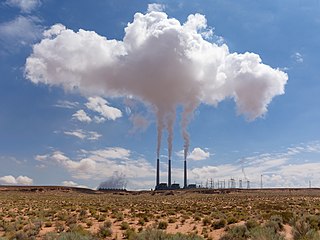
India is the third largest producer of electricity in the world. During the fiscal year (FY) 2022–23, the total electricity generation in the country was 1,844 TWh, of which 1,618 TWh was generated by utilities.

A fossil fuel power station is a thermal power station which burns a fossil fuel, such as coal or natural gas, to produce electricity. Fossil fuel power stations have machinery to convert the heat energy of combustion into mechanical energy, which then operates an electrical generator. The prime mover may be a steam turbine, a gas turbine or, in small plants, a reciprocating gas engine. All plants use the energy extracted from the expansion of a hot gas, either steam or combustion gases. Although different energy conversion methods exist, all thermal power station conversion methods have their efficiency limited by the Carnot efficiency and therefore produce waste heat.

FirstEnergy Corp is an electric utility headquartered in Akron, Ohio. It was established when Ohio Edison merged with Centerior Energy in 1997. Its subsidiaries and affiliates are involved in the distribution, transmission, and generation of electricity, as well as energy management and other energy-related services. Its ten electric utility operating companies comprise one of the United States' largest investor-owned utilities, based on serving 6 million customers within a 65,000-square-mile (170,000 km2) area of Ohio, Pennsylvania, West Virginia, Virginia, Maryland, New Jersey, and New York. Its generation subsidiaries control more than 16,000 megawatts of capacity, and its distribution lines span over 194,000 miles. In 2018, FirstEnergy ranked 219 on the Fortune 500 list of the largest public corporations in the United States by revenue.

Eraring Power Station is a coal-fired power station consisting of four 720 MW Toshiba steam-driven turbo-alternators for a combined capacity of 2,880 MW. The station is located near the township of Dora Creek, on the western shore of Lake Macquarie, New South Wales, Australia and is owned and operated by Origin Energy. It is Australia's largest power station. The plant has two smokestacks rising 200 m (656 ft) in height. It is slated for closure by mid-2025.

The William H. Zimmer Power Station, located near Moscow, Ohio, was a 1.35-gigawatt coal power plant. Planned by Cincinnati Gas and Electric (CG&E), with Columbus & Southern Ohio Electric and Dayton Power & Light (DP&L) as its partners, it was originally intended to be a nuclear power plant. Although once estimated to be 97% complete, poor construction and quality assurance (QA) led to the plant being converted to coal-fired generation. The plant began operations in 1991. Today, the plant is owned and operated by Vistra Corp.

Ohio Citizen Action is an advocacy group representing 32,000 members throughout Ohio. Over its history the organization has worked on issues as diverse as single-payer healthcare, expanding access to organic produce in grocery stores, and speeding Ohio's embrace of a just and equitable clean energy economy. The organization was founded in Cleveland in 1975 as the Ohio Public Interest Campaign (OPIC), a coalition of union, senior citizen, church, and community organizations. Responding to a wave of factory closings in Northeast Ohio, the coalition proposed state legislation to require advance notice to employees before a closing (1977). The Ohio legislature balked, so U.S. Senator Howard Metzenbaum (D-OH) sponsored it as a federal bill. It became federal law in 1988. In 1989, the Ohio Public Interest Campaign changed its name to Ohio Citizen Action to reflect its change from a coalition to a membership organization. Their headquarters is located fifteen minutes south of downtown Cleveland, on Brookpark Road.
The Acid Rain Program is a market-based initiative taken by the United States Environmental Protection Agency in an effort to reduce overall atmospheric levels of sulfur dioxide and nitrogen oxides, which cause acid rain. The program is an implementation of emissions trading that primarily targets coal-burning power plants, allowing them to buy and sell emission permits according to individual needs and costs. In 2011, the trading program that existed since 1995 was supplemented by four separate trading programs under the Cross-State Air Pollution Rule (CSAPR). On August 21, 2012, the United States Court of Appeals for the District of Columbia issued its Opinion and Order in the appeal of the Cross State Air Pollution Rule (CSAPR) for two independent legal reasons. The stay on CSAPR was lifted in October 2014, allowing implementation of the law and its trading programs to begin.

Kingston Fossil Plant, commonly known as Kingston Steam Plant, is a 1.4-gigawatt coal-fired power plant located in Roane County, just outside Kingston, Tennessee on the shore of Watts Bar Lake. It is operated by the Tennessee Valley Authority. The plant is known for the Kingston Fossil Plant fly ash spill which occurred in December 2008.

Coal generated about 19.5% of the electricity at utility-scale facilities in the United States in 2022, down from 38.6% in 2014 and 51% in 2001. In 2021, coal supplied 9.5 quadrillion British thermal units (2,800 TWh) of primary energy to electric power plants, which made up 90% of coal's contribution to U.S. energy supply. Utilities buy more than 90% of the coal consumed in the United States. There were over 200 coal powered units across the United States in 2022. Coal plants have been closing since the 2010s due to cheaper and cleaner natural gas and renewables. But environmentalists say that political action is needed to close them faster, to reduce greenhouse gas emissions by the United States to better limit climate change.

F. B. Culley Generating Station is a 369 megawatt (MW) coal power plant located southeast of Newburgh in Warrick County, Indiana. It sits on the north bank of Ohio River, immediately adjacent and upstream of the Warrick Power Plant, and is owned and operated by Vectren.

Luminant is a Texas-based electric utility. It is a wholly owned subsidiary of Energy Future Holdings Corporation. Luminant's operations include electricity generation and wholesaling, mining, construction, and development. The company has capacity for the generation of 18,300 megawatts (MW) of electricity in 20 power plants spread across Texas, of which 2,300 MW come from nuclear power generated at the company's Comanche Peak Nuclear Power Plant, 5,800 MW from coal-fired power plants, and the remainder from natural gas-fired plants. Luminant is also a major purchaser of wind power.
Armstrong Power Station was a 356 megawatt (MW), coal power plant in Washington Township, Armstrong County along the Allegheny River across from Mahoning Creek and Templeton, Pennsylvania, about 10 miles (16 km) north of Kittanning, Pennsylvania. The plant operated from 1958 to 2012.

The E. W. Brown Generating Station is a quad coal-fired power plant, natural gas power plant, solar power plant, and hydro electric plant owned and operated by Kentucky Utilities near Harrodsburg in Mercer County, Kentucky.

The R. Paul Smith Power Station is a closed electric generating plant owned by FirstEnergy in Williamsport, Maryland.

The Clean Power Plan was an Obama administration policy aimed at combating anthropogenic climate change that was first proposed by the Environmental Protection Agency (EPA) in June 2014. The final version of the plan was unveiled by President Obama on August 3, 2015. Each state was assigned an individual goal for reducing carbon emissions, which could be accomplished how they saw fit, but with the possibility of the EPA stepping in if the state refused to submit a plan. If every state met its target, the plan was projected to reduce carbon emissions from electricity generation 32% by 2030, relative to 2005 levels, as well as achieving various health benefits due to reduced air pollution.
Sandow Power Plant was a 1.1-gigawatt coal power plant located southwest of Rockdale, Texas in Milam County, Texas. It was operated by Luminant, a subsidiary of Vistra Corp. The plant closed in 2018.
R.E. Burger Power Station was a 568 megawatt (MW), coal power plant located south of Shadyside, Ohio in Belmont County, Ohio. The plant closed in 2011. It was operated by FirstEnergy.

Bruce Mansfield Power Plant was a 2.49-gigawatt, coal power plant located in Shippingport, Pennsylvania in Beaver County, Pennsylvania. The plant was operated by FirstEnergy. It began operations in 1976 and was shut down in November 2019.
Picway Power Plant was a 220 megawatt (MW) coal power plant located west of Lockbourne in Pickaway County, Ohio. The plant generated electricity from 1926 until its closure in 2015. It was operated by American Electric Power (AEP).

Conesville Power Plant was a 2-gigwatt, coal power plant located east of Conesville, Ohio in Coshocton County, Ohio. Its units were co-owned at the time of its closing by American Electric Power (AEP) and AES Ohio Generation. All plant operations were handled by AEP. Conesville began operations in 1957 and ceased generation in April 2020.
















